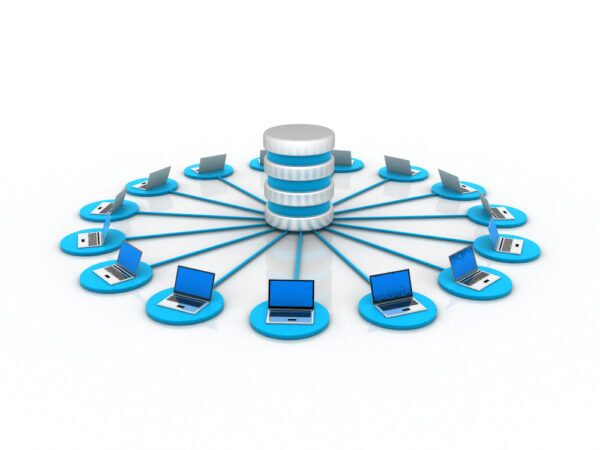
As industrial organizations modernize their IT infrastructure, the choice between on-premise web-based computerized maintenance management system (CMMS) software and traditional client-server systems becomes critical. This article provides an overview of the key advantages of adopting an on-premise web-based application model over a legacy client-server approach.
Why Organizations are Moving Away from Client-Server Models

As with other types of business software, CMMS has been traditionally deployed on-premise using a client-server model. In this setup, the core application and database are installed on an on-site server, while each user’s workstation requires dedicated client software installed to access the system.
Limitations of Client-Server Architecture
For many years, the client-server model was the only viable way to deliver enterprise software – especially before the rise of the internet and cloud-based computing. While this architecture served its purpose at the time, it now poses several challenges to today’s modern IT environments:
- Complex Software Installation: Each client must have compatible software installed, updated, and supported.
- Operating System Lock-In: Often limited to specific OS platforms.
- Limited Scalability: Adding new users or remote locations can require infrastructure changes.
- Challenging Remote Access: Requires VPN or remote desktop for external users.
- Complex Integration: Legacy systems may not support modern APIs or connectivity standards.
- Limited Mobility: Designed for use on-site; remote or mobile access is often cumbersome.
Evolving Enterprise Needs
In addition to the IT infrastructure limitations, the client-server model also falls short of modern business needs and user expectations. Today’s organizations demand:
- Better user experience provided through a clean (uncluttered), intuitive, browser-based interface.
- Cross-device access that allows teams to work from the plant floor, out in the field, and anywhere in between
- Faster development and deployment to allows operations to continue with minimal interruptions
- Centralized control that makes it easy to manage user access, authentication, and updates from a single location
The Shift Towards On-Premise Web-Based Software
While many organizations are able to modernize their IT infrastructure by adopting cloud-based CMMS, those in regulated industries such as healthcare, government, pharmaceuticals, food and beverage, and defense cannot or will not use public cloud infrastructure. In addition, many organizations that have strict IT and security policies or unreliable internet access find difficulty using cloud-based systems. This creates some issues, as enterprises still seek modern software experiences. That’s where on-premise web-based CMMS comes in.
On-premise web-based CMMS is a CMMS solution that is installed on an on-site server and accessed through a web browser. Unlike the client-server model, there is no client software to install. Instead, users simply open a web browser or properly-configured mobile app and connect to the CMMS through their local network. This setup creates a practical middle ground between on-premise and cloud-based systems – end users benefit from an accessible, modern CMMS while administrators are able to retain control over their maintenance data and security controls.
Advantages of On-Premise Web-Based Software
On-premise web-based software brings together many of the benefits of traditional on-premise systems and web-based applications:
- Local Network Accessibility: Web applications can be accessed through the internal network using a browser, eliminating the need for location-specific installations.
- No Client Installation Required: Users simply log in via a local URL. No software needs to be installed on individual machines.
- Centralized Updates and Maintenance: All application logic and updates reside on the internal server. When updates are made, every user automatically receives the latest version.
- Cross-Platform Compatibility: Web apps work on any operating system, including Windows, macOS, Linux, and mobile devices, without requiring special versions.
- Scalability and Integration Readiness: Built to easily integrate with local RESTful APIs and scalable infrastructure, on-premise web applications support growth and internal connectivity.
- Centralized Security Management: Web applications enable centralized enforcement of authentication, authorization, SSL, and firewall rules within the local network.
- Lower Total Cost of Ownership (TCO): Eliminate desktop software licenses, reduce manual update tasks, and lower IT overhead.
- Rapid Deployment: New users can be added simply by creating an account and providing a local URL—no complex setup required.
- Real-Time Collaboration: Built-in support for dashboards, live updates, notifications, and shared access enhances team productivity.
- Built-in Usage Analytics: Easily track internal user behavior and feature adoption through local web analytics and telemetry tools.
As you can see, on-premise web-based software solutions offer organizations a clear path to improved accessibility, reduced maintenance, and better user experience within a secure and controlled environment. Web applications are the preferred choice for most modern business environments.
FTMaintenance Select: Your On-Premise CMMS Solution
With more and more CMMS vendors abandoning on-premise support in favor of cloud-based solutions, many maintenance teams are being left behind.
FasTrak SoftWorks, provider of FTMaintenance Select, recognizes that not every organization can or should be forced into the cloud. That’s why FTMaintenance Select remains one of the few modern CMMS solutions available in a fully on-premise, web-based deployment, providing you with all the benefits of modern CMMS while existing within your controlled IT environment. This includes full access to our mobile app and requester portal.
On-premise CMMS isn’t just a preference – for many, it’s a requirement. Contact us today to explore how FTMaintenance Select can meet your on-premise deployment needs.